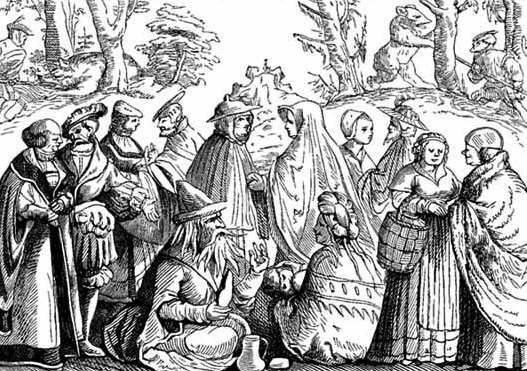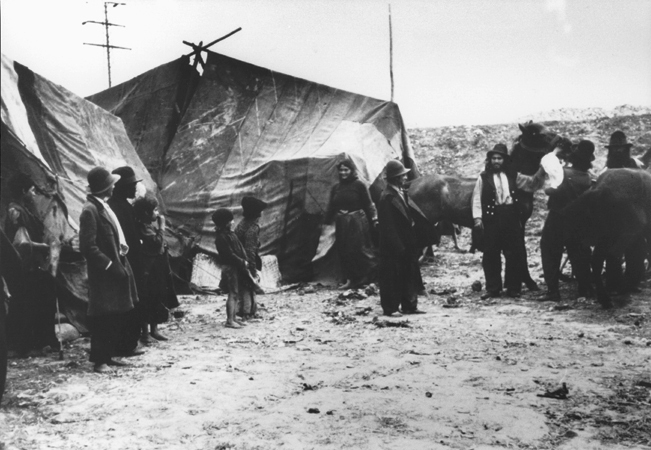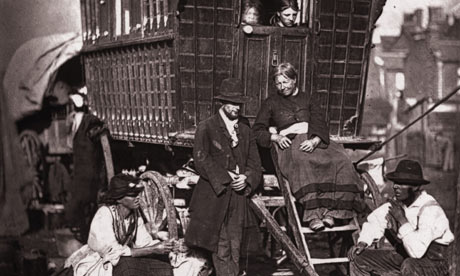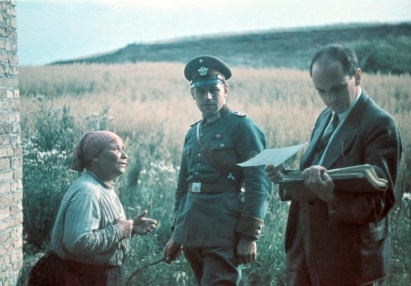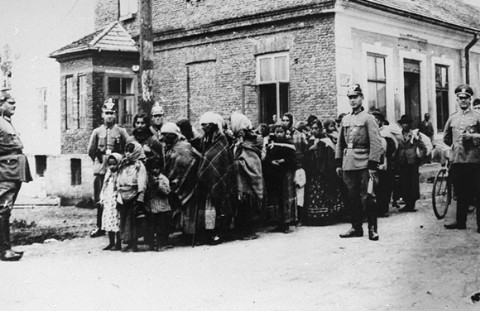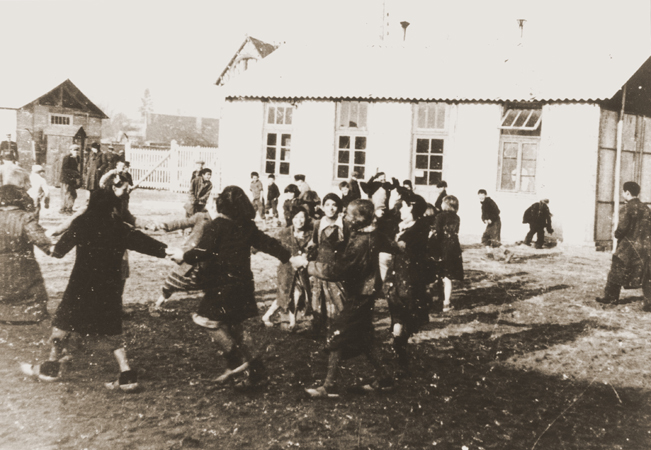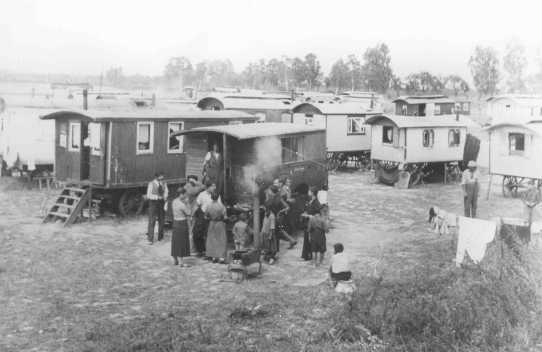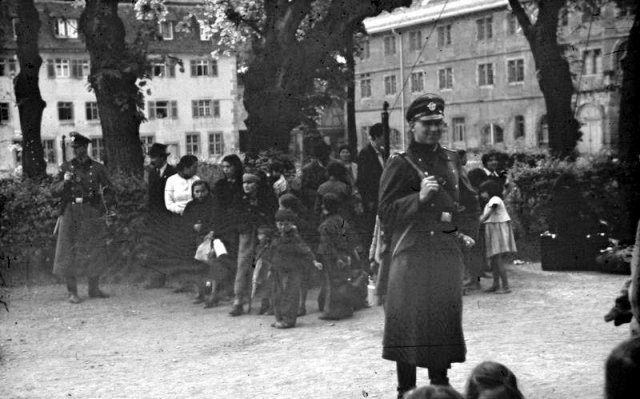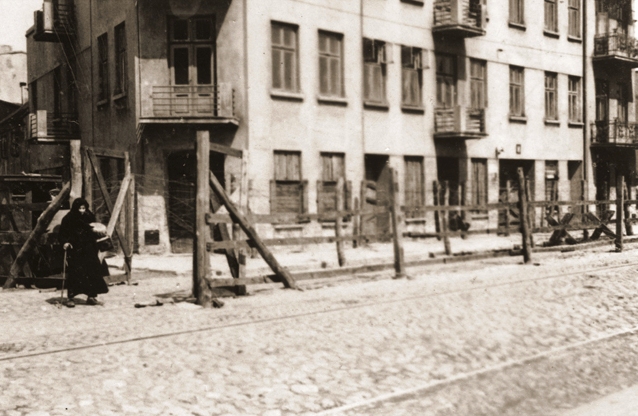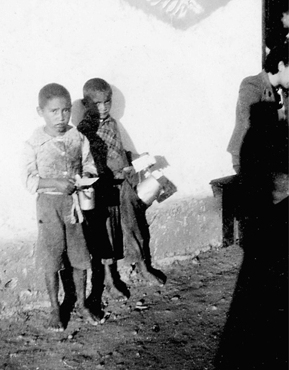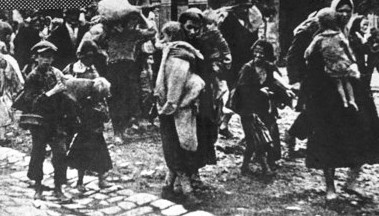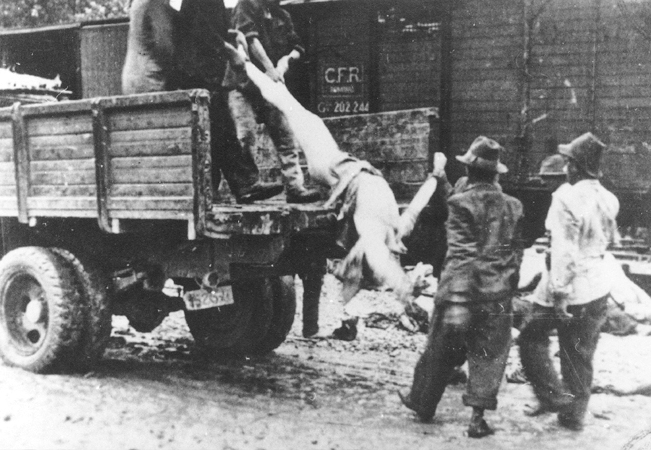The first memorial commemorating victims of the Romani Holocaust was erected on May 8, 1956, in the Polish village of Szczurowa commemorating the Szczurowa massacre. Since 1996, a Gypsy Caravan Memorial is crossing the main remembrance sites in Poland, from Tarnów via Auschwitz, Szczurowa and Borzęcin Dolny, gathering the Gypsies and well-wishers in the remembrance of those murdered during the Nazi regime
Holocaust Education & Archive Research Team |
|
Holocaust Prelude Early Nazi Leaders Nazi Propaganda Nazi Racial Laws Sinti & Roma Kristallnacht The SS SS Leadership Wannsee
Prelude Articles Image Galleries | |||||||
Sinti & Roma The "Gypsies"
The Sinti and Roma are nomadic peoples found throughout Europe and the United States. Often both groups are referred to as Roma, collectively, they are popularly referred to as Gypsies. It is derived from "Egypt", for it is believed that when the Roma first arrived in Europe their relatively dark skins caused many Europeans to believe that they were natives of Egypt.
Linguistic experts compare Gypsy languages to historical languages; they look at words borrowed from other languages and when and where those words originally existed. It is possible to trace Gypsies back to their origin: the Sind area of India (today south central Pakistan -- the mouth of the Indus).
Three separate emigrations occurred over the course of about four hundred years, traceable today in three identifiable linguistic populations: the Eastern Gypsy (Domari) in Egypt and the Middle East, the Central Gypsy (Lomavren) in Armenia and eastern Turkey, and the Western Gypsy (Romani) (Romany refers to the people, Romani refers to the language, Rom refers to a man or the people as a whole.
The Sinti and Roma are believed to have left India about 1000 A.D. and to have passed through what is now Afghanistan, Persia, Armenia, and Turkey. People recognizable by other Roma as Roma still live as far east as Iran, including some who made the migration to Europe and returned. It is virtually impossible to identify Roma still living in India. By the 14th century, Roma had reached the Balkans and by the 16th century, Scotland and Sweden. Some Roma migrated south through Syria to North Africa. For centuries, Sinti and Roma were scorned and persecuted in Europe. Zigeuner, the German word for Gypsy, derives from a Greek root meaning “untouchable.” In the Balkan principalities of Moldavia and Wallachia, Gypsies were slaves bought and sold by monasteries and large estate holders (boyars) until 1864, when the newly formed nation of Romania emancipated them.
In post WWI Germany, persecution of the Sinti and Roma preceded the Nazi regime. Even though Gypsies enjoyed full and equal rights of citizenship under Article 109 of the Weimar Constitution, they were subject to special, discriminatory laws. A Bavarian law of July 16,1926, outlined measures for “Combatting Gypsies,Vagabonds, and the Work Shy” and required the systematic registration of all Sinti and Roma.
When Hitler took power in 1933, anti-Gypsy laws remained in effect. Soon the regime introduced other laws affecting Germany’s Sinti and Roma, as the Nazis immediately began to implement their vision of a new Germany — one that placed “Aryans” at the top of the hierarchy of races and ranked Jews, Gypsies, and blacks as racial inferiors. "Like the Jews, Gypsies were singled out by the Nazis for racial persecution and annihilation. They were 'nonpersons,' of 'foreign blood,' 'labor-shy,' and as such were termed asocial. To a degree, they shared the fate of the Jews in their ghettos, in the extermination camps, before firing squads, as medical guinea pigs, and being injected with lethal substances. The Nuremberg racial laws of September 15, 1935, ("Law for the Protection of German Blood and Honor" and "Reich Citizenship Law") did not explicitly mention Gypsies, but in commentaries interpreting these laws, Gypsies were included, along with Jews and "Negroes," as "racially distinctive" minorities with "alien blood." As such, their marriage to "Aryans" was prohibited. Like Jews, Gypsies were also deprived of their civil rights.
In June 1936, a Central Office to "Combat the Gypsy Nuisance" opened in Munich. This office became the headquarters of a national data bank on Gypsies. Also in June, part of the Ministry of Interior directives for "Combating the Gypsy Nuisance" authorized the Berlin police to conduct raids against Gypsies so that they would not mar the image of the city, host of the summer Olympic games.
That July, the police arrested 600 Gypsies and brought them, in 130 caravans, to a new, special Gypsy internment camp (Zigeunerlager) established near a sewage dump and cemetery in the Berlin suburb of Marzahan. The camp had only three water pumps and two toilets; in such overcrowded and unsanitary conditions, contagious diseases flourished.
Police and their dogs guarded the camp. Similar Zingeunerlageralso appeared in the 1939s, at the initiative of municipal governments and coordinated by the Council of Cities (reporting to the Ministry of Interior), in Cologne, Düsseldorf, Essen, Frankfurt, Hamburg, and other German cities.
The children of Sinti and Roma were also victims, interned with their families in the municipal camps and studied and classified by racial scientists. Between 1933 and 1939, authorities took many Sinti and Roma children from their families and brought them to special homes for children as wards of the state.
Gypsy schoolchildren who were truant were deemed delinquent and sent to special juvenile schools; those unable to speak German were deemed feeble-minded and sent to “special schools” for the mentally handicapped.
Like Jewish children, Gypsy boys and girls also commonly endured the taunts and insults of their classmates, until March 1941 when the regime excluded Gypsies from the public schools. Heinrich Himmler Memorandum, December 8, 1938: Experience gained in combating the Gypsy nuisance, and knowledge derived from race-biological research, have shown that the proper method of attacking the Gypsy problem seems to be to treat it as a matter of race. Experience shows that part-Gypsies play the greatest role in Gypsy criminality. On the other hand, it has been shown that efforts to make the Gypsies settle have been unsuccessful, especially in the case of pure Gypsies, on account of their strong compulsion to wander. It has therefore become necessary to distinguish between pure and part-Gypsies in the final solution of the Gypsy question.
To this end, it is necessary to establish the racial affinity of every Gypsy living in Germany and of every vagrant living a Gypsy-like existence. I therefore decree that all settled and non-settled Gypsies, and also all vagrants living a Gypsy-like existence, are to be registered with the Reich Criminal Police Office-Reich Central Office for Combating the Gypsy Nuisance. The police authorities will report (via the responsible Criminal Police offices and local offices) to the Reich Criminal Police Office-Reich Central Office for Combating the Gypsy Nuisance all persons who by virtue of their looks and appearance, customs or habits, are to be regarded as Gypsies or part-Gypsies.
During May 1940, about 3,100 were sent to Jewish ghettos in the Government-General: others may have been added to Jewish transports from Berlin, Vienna, and Prague to Nisko, Poland (the sight of an aborted reservation to which Jews were deported). These measures were taken against Gypsies who had no claim to exemption because of having an Aryan spouse or having been regularly employed for five years.
At a conference held on January 30, 1940, a decision was taken to expel 30,000 Gypsies from Germany to the territories of occupied Poland. Einsatzgruppen reports from groups operating in the occupied territories of the Soviet Union mention the murder of thousands of Gypsies along with the massive extermination of the Jews in these areas.
The legal status of Gypsies and Jews, determined irrevocably by the agreement between Justice Minister Thierack and SS Reichsfuehrer Himmler on 18 September 1942, removing both groups from the jurisdiction of any German court, confirmed their fate.
Now with all legal obstacles removed, the deportations and executions of the Gypsies came under Himmler's full authority. On December 16, 1942, Himmler issued an order to send all Gypsies to the concentration camps, with a few exceptions. In western and southern Europe, the fate of Sinti and Roma varied from country to country, depending on local circumstances. Across German-occupied Europe, Gypsies, like Jews, were interned, killed, or deported to camps in Germany or eastern Europe.
The collaborationist regime of Vichy France interned 30,000 Gypsies, many of whom were later deported to Dachau, Ravensbrück, Buchenwald, and other camps. In Croatia, members of the local fascist Ustasha movement killed tens of thousands of Gypsies, along with Serbs and Jews. Adolf Eichmann telegram from Vienna to the Gestapo:
Regarding transport of Gypsies be informed that on Friday, October 20, 1939, the first transport of Jews will depart Vienna. To this transport 34 cars of Gypsies are to be attached. Subsequent trains will depart from Vienna, Mahrisch-Ostrau and Katowice.
The simplest method is to attach some carloads of Gypsies to each transport. Because these transports must follow schedule, a smooth execution of this matter is expected. Concerning a start in the Altreich (Germany proper) be informed that this will be coming in 34 weeks. In Romania in 1941 and 1942, thousands of Gypsies were expelled, alongside Jews, to Transnistria (western Ukraine) where most of the deportees died from disease, starvation, and brutal treatment. In Serbia, in the fall of 1941, German army firing squads killed almost the entire adult male Gypsy population, alongside most adult male Jews, in retaliation for German soldiers killed by Serbian Resistance fighters. Most often, the German police deported Roma in the Greater German Reich to Auschwitz-Birkenau, where the camp authorities housed them in a special compound that was called the "Gypsy family camp." Some 23,000 Roma, Sinti and Lalleri were deported to Auschwitz altogether. In the so-called Gypsy compound, entire families lived together.
SS medical researchers assigned to the Auschwitz complex, such as SS Captain Dr. Josef Mengele, received authorization to choose human subjects for pseudoscientific medical experiments from among the prisoners in the Auschwitz concentration camp complex. Mengele chose twins and dwarves, some of them from the Gypsy family camp, as subjects of his experiments.
Hungarian Roma survivor Holdosi Vilmosné recounts:
They cut off our hair… and everything to be hairless. It was done by women, then a doctor examined us thoroughly… they examined, you know, everything. He was the one who gave an injection to me and to all the others, to everybody. It hurt badly.
You know, he gave me an injection down there…Everything went black… I fell off that examining table. They kicked me away, it was time for the next. They gave me an injection like that one in eight months and after that I did not have that monthly thing
Approximately 3,500 adult and adolescent Roma were prisoners in other German concentration camp; medical researchers selected subjects from among the Roma incarcerated in Ravensbrück, Natzweiler-Struthof, and Sachsenhausen concentration camps for their experiments, either on site in the camps or at nearby institutes.
Roman Mirga a Gypsy survivor from Auschwitz recalls the gassing process:
I suddenly heard music. In the distance violins were playing 'The Blue Danube'... It was intended to calm the Jews going inside, soap and towels in their hands, no doubt believing they were taking a bath. Except that it was not a bath-house, but a crematorium.
The Gypsy orchestra was there...their music helping to make a smooth transition for the Jews from life to death
In May 1944, the camp leadership decided to murder the inhabitants of the Gypsy compound. The SS guards surrounded and sealed off the compound. When ordered to come out, the Roma refused, having been warned and having armed themselves with iron pipes, shovels, and other tools used for labor.
The camp staff killed virtually all in the gas chambers of Birkenau. A handful of children who had hidden during the operation were captured and killed in the following days. At least 19,000 of the 23,000 Roma sent to Auschwitz died there.
Sources: Hans F. K. Günther as quoted in Philip Friedman, The Extermination of the Gypsies: Nazi Genocide of an Aryan People. Translated in Michael Burleigh and Wolfgang Wipperman, The Racial State: Germany 1933–1945 (New York, 1991), pp. 120–21. Milton, Sybil. “The Holocaust: The Gypsies,” in William S. Parsons, Israel Charny, and Samuel Totten Genocide in the Twentieth Century: An Anthology of Critical Essays and Oral History Müller-Hill, Benno. Murderous Science: Elimination by Scientific Selection of Jews, Gypsies, and Others: Germany, 1933–1945 Tyrnauer, Gabrielle. Gypsies and the Holocaust: A Bibliography and Introductory Essay (Montreal, 1989).. The "Years of extermination" by Saul Friedlander. First Harper Perennial 2008 USHMM Report on Sinti and Roma
Copyright: Carmelo Lisciotto H.E.A.R.T 2010
|
